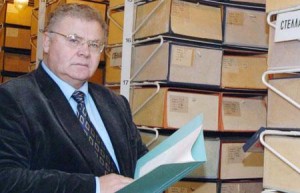 ALMATY – On Jan. 14, 1994, a presidential decree on the creation of Kazakhstan’s Presidental Archive was signed. To celebrate the upcoming 20th anniversary of this archive, we asked its director Vladimir Shepel to tell more about it.
ALMATY – On Jan. 14, 1994, a presidential decree on the creation of Kazakhstan’s Presidental Archive was signed. To celebrate the upcoming 20th anniversary of this archive, we asked its director Vladimir Shepel to tell more about it.
Perhaps the most unique trait of the archives is the quality of its records. It is a modern, high-tech complex. Since 1998, the Archive has collected 70 files relating to political, governmental and public figures of Kazakhstan (about 8,000 records are in storage now). The archive includes files on Dzhienbayev, Zhanybekov, Beisebayev, Ospanov, Alimzhanov, Kozybayev, Belger, Isinaliyev and other people who worked in the government of Kazakhstan during the Soviet times.
The Presidental Archive is a national scientific-methodological centre that has issued over 90 manuals. Information and a detailed newsletter are issued regularly.
In 2011, a historical exhibition series titled the “Chronicle of Independence” was held in Astana in conjunction with Kazakhstan’s Museum of the First President, and an exhibition titled “Under the flag of Independence” was done together with the Ministry of Foreign Affairs and the “Rarities of the President’s Archive”. These exhibitions attracted more than 15,000 visitors, including foreign ambassadors.
“We have published 59 documentary collections and references in 64 volumes,” Shepel said. Thousands of documents, previously unavailable to researchers, have been made accessible. Articles are regularly published on political history. Radio and television broadcasts, exhibitions, lectures, excursions, school field trips and open days are held on a regular basis too.
“We are cooperating with other countries’ archives and the International Council on Archives (ICA), of which Kazakhstan has been a member (in the Eurasian department) since 2003,” Shepel said. “Compared to 1994, funding to our archive has increased 17 times, modern equipment was also procured.”
In 2010, the high-tech German microfiche COM system was first applied, in 2011, new air conditioners were installed in the facility’s storage units and then the outdated e-filing server was replaced.
The records are held in 8 storage facilities with stationary and modern mobile shelves that reach 29 km in length. All of these spaces are equipped with automated artificial climate and fire safety systems.
“We introduced 16 automated accounting and information retrieval databases. An e-reference service on Soviet Kazakhstan’s political elite from1918 to 1991 is in the making,” Shepel added.
In 2008, the frequently updated website www.aprk.kz was launched.
The most valuable records on post independence Kazakhstan are ones on the history of the formation and development of the nation, including a historic speech of President Nursultan Nazarbayev on gaining sovereignty at a Supreme Council session and documents surrounding the adoption of the Constitution and the swearing in of the President on Dec. 10, 1991, confirmations from world leaders on their acknowledgements of Kazakhstan’s sovereignty, the UN General Assembly’s resolution on Kazakhstan’s UN membership, the constitutional laws and decrees from the President “On Adoption of the State Symbols of the Republic of Kazakhstan”, “Launch of the National Currency” and others.
All of these documents and many other valuable archival records point to the importance and complexity of the path Kazakhstan has blazed and to the first President’s role in the country’s progress.


